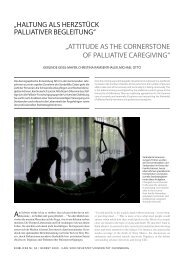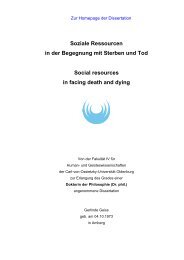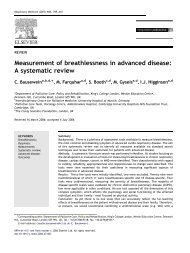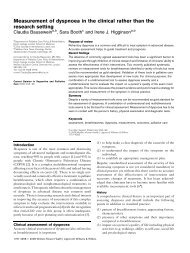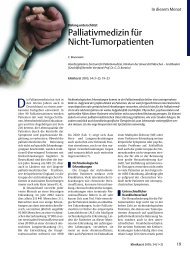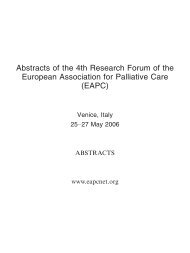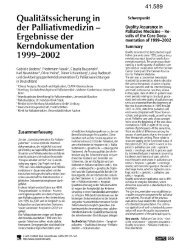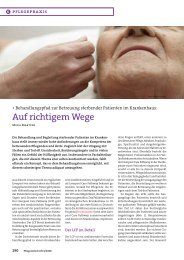EAPC - ipac
EAPC - ipac
EAPC - ipac
You also want an ePaper? Increase the reach of your titles
YUMPU automatically turns print PDFs into web optimized ePapers that Google loves.
412 <strong>EAPC</strong> Abstracts<br />
Background: Malignant wounds, caused by direct invasion of cancer into<br />
the skin, occur in cancer patients with primary skin tumors, and as<br />
cutaneous metastasis in about 10% of patients with metastatic internal<br />
malignancies. Malignant wounds can have a profound impact on patients,<br />
family members and clinicians. Assessment of the patient with a malignant<br />
wound is complex, and until now, there has been no widely accepted, consistent<br />
approach. Valid, descriptive survey research methods were used to<br />
develop the Malignant Wound Assessment Tool (MWAT). Methods: We<br />
developed two versions of the MWAT: a brief clinical version (MWAT-C)<br />
and a more detailed research version (MWAT-R). Domains include clinical<br />
wound features (size, location, classification), physical effects (pain, odor,<br />
exudate, bleeding, edema and functional impairment), and emotional and<br />
social impacts. The two tools then underwent content and construct validity<br />
testing using a Delphi process, involving professionals with significant<br />
clinical or research expertise related to malignant wounds. An international<br />
expert panel was formed (n=32 members from Canada, US, UK, Denmark,<br />
and New Zealand). Panelists were given the option to review one or both<br />
tools. Results: Panelists participated in two rounds of review for each tool.<br />
Response rates were acceptable for each round. For both tools, there was a<br />
positive shift between rounds of review resulting in substantial consensus<br />
on individual tool items. Conclusions: Validity testing of the MWAT-C and<br />
MWAT-R tools through the Delphi process has resulted in tools, which we<br />
will share at the conference, that can support clinical and research activities<br />
designed to improve care for patients. Next steps will include dissemination<br />
of the tools for routine use, and further validation and reliability studies<br />
involving patients in various practice and research settings. Funding provided<br />
by: Canadian Institutes of Health Research Grant PET69772.<br />
43 Oral Presentation<br />
Assessment and measurement tools<br />
Palliative Care Staff Satisfaction: The Survey of Team Attitudes<br />
and Responses (STAR)<br />
Authors: Stephen Connor Research and International Development<br />
National Hospice and Palliative Care Organization U. STATES<br />
David Casarett, MD The Center for Health Equity Research and<br />
Promotion, University of Pennsylvania, VAMC Philadelphia, Pennsylvania<br />
U. STATES<br />
Brye Quaseem, PhD, MPH The Center for Health Equity Research and<br />
Promotion, University of Pennsylvania, VAMC Philadelphia, Pennsylvania<br />
U. STATES<br />
Judy Shea, PhD The Center for Health Equity Research and Promotion,<br />
University of Pennsylvania, VAMC Philadelphia, Pennsylvania U. STATES<br />
Background: Despite the emotional and interpersonal challenges that hospice<br />
and palliative care workers face in providing care to patients near the<br />
end of life, no systematic effort has been made to evaluate the work environment<br />
that hospice and palliative care providers provide to their staff. The<br />
aim of this project was to develop a job satisfaction survey that could be<br />
used to evaluate the hospice work environment and, ultimately, to guide<br />
interventions to improve the work experience for hospice staff. Methods:<br />
The Survey of Team Attitudes and Relationships (STAR) was developed<br />
through semistructured interviews with an interdisciplinary sample of staff<br />
from nine hospices, and then refined with input from additional interviews<br />
and from an expert panel. The draft was tested on larger samples of staff<br />
(n 1 /4 160) from six hospices and revised with input from the expert panel.<br />
The final survey was tested with 599 staff from 10 hospices. Results: The<br />
final survey contains 45 items in six domains: individual work rewards,<br />
teamwork, management support,organizational support, workload issues,<br />
and global assessment of job satisfaction. Items had excellent psychometric<br />
characteristics, with acceptable floor and ceiling effects. The overall STAR<br />
had a Cronbach’s alpha of 0.93, indicating good homogeneity, and each<br />
domain had alpha values that are appropriate for between-group comparisons<br />
(range 0.74e0.84). Conclusions: These results suggest that the STAR<br />
offers a unique instrument to measure the work environment hospices and<br />
palliative care programs provide to their staff. Workforce excellence is a<br />
significant factor in the provision of quality palliative care and poses unique<br />
challenges for palliative care providers. This survey has now been introduced<br />
to all hospice and palliative care providers in the United States by the<br />
National Hospice and Palliative Care Organization and will be used to<br />
benchmark staff satisfaction throughout the over 4,000 US hospice<br />
providers and may be useful in other countries.<br />
44 Oral Presentation<br />
Assessment and measurement tools<br />
Detecting psychological distress in palliative care: validating<br />
screening tools against psychiatric interview<br />
Presenting author: Mike Bennet<br />
Authors: Parvez Thekkumpurath School of Molecular & Clinical Medicine<br />
University of Edinburgh UNITED KINGDOM<br />
Chitra Venkateswaran St.Gemma’s Hospice Leeds UNITED KINGDOM<br />
Manoj Kumar Leeds Mental Health Trust Leeds UNITED KINGDOM<br />
Mike Bennett International Observatory on End of Life Care, Lancaster<br />
University Lancaster UNITED KINGDOM<br />
Background: Psychological distress is common but not routinely picked<br />
up in palliative care. Systematic and routine screening is now recommended<br />
in most cancer settings. Examining validity of screening questionnaires<br />
is an essential step prior to their use in this population. This study<br />
examined the validity of Distress Thermometer (DT) along with two other<br />
screening questionnaires (BSI-18, GHQ-12 ) in detecting psychological<br />
distress in the terminally ill by comparing against a semi structured psychiatric<br />
interview: Schedules for Clinical Assessment in Neuropsychiatry<br />
(SCAN). Methods: Consecutive and eligible patients were recruited from<br />
inpatient and day hospice attendees at St. Gemma’s and Wheatfield’s<br />
Hospices, Leeds. Patients completed the three questionnaires, adapted on<br />
to a on a touch screen format. Within 72 hours, the gold standard psychiatric<br />
interview, SCAN, was conducted by one of the two trained psychiatrists<br />
with established inter-rater reliability. The questionnaires were<br />
compared against the SCAN interview using Receiver operator curve<br />
(ROC) analysis. Results: A total of 226 patients were approached,52 opted<br />
out and 24 dropped out. 150 patients completed all interviews. The mean<br />
age was 70 years (SD 12). More than half of the sample died within<br />
six weeks of the interview (median survival time: 44 days. We found 34%<br />
of our sample had psychiatric morbidity; the commonest form of distress<br />
is Adjustment disorder (22%), and not Depressive disorders (7%). A past<br />
history of psychological problems/treatments was significantly associated<br />
with the presence of distress. The three questionnaires perform reasonably<br />
well in correctly identifying distress in this population. All show an area<br />
under the curve of >0.725. Distress Thermometer at a cut off of 5,shows a<br />
sensitivity of 0.77 and sensitivity of 0.59 with a positive predictive value<br />
of 50%. Conclusions: Given the similar performance of the three screening<br />
questionnaires, we recommend using Distress Thermometer, which is<br />
the briefest and easiest to complete.<br />
45 Oral Presentation<br />
Assessment and measurement tools<br />
Measuring hopelessness at the end of life<br />
Authors: Barry Rosenfeld Psychology Fordham University U. STATES<br />
William Breitbart Memorial Sloan-Kettering Cancer Center New York<br />
U. STATES<br />
Hayley Pessin Memorial Sloan-Kettering Cancer Center New York, NY<br />
U. STATES<br />
Background: Hopelessness has been increasingly recognized as a critical<br />
factor in end-of-life decision making (e.g. terminating life-sustaining treatments,<br />
suicidal attempts). Yet hopelessness is poorly understood, particularly<br />
in the context of a terminal illness. Current measures are often too long<br />
and contain inappropriate items for palliative care patients. This paper



